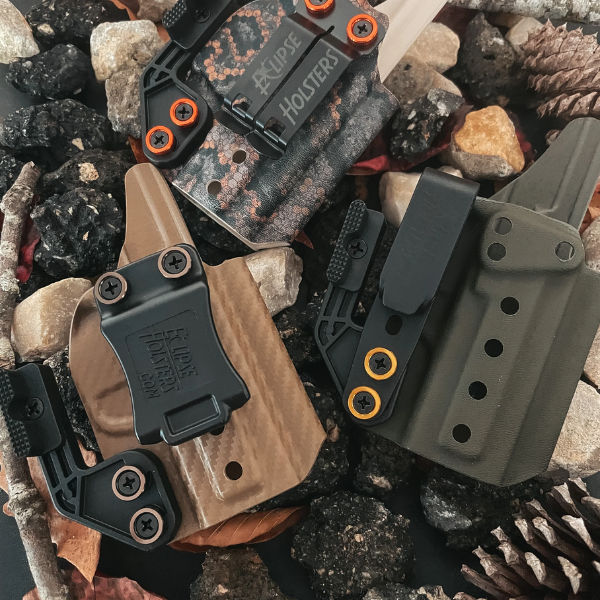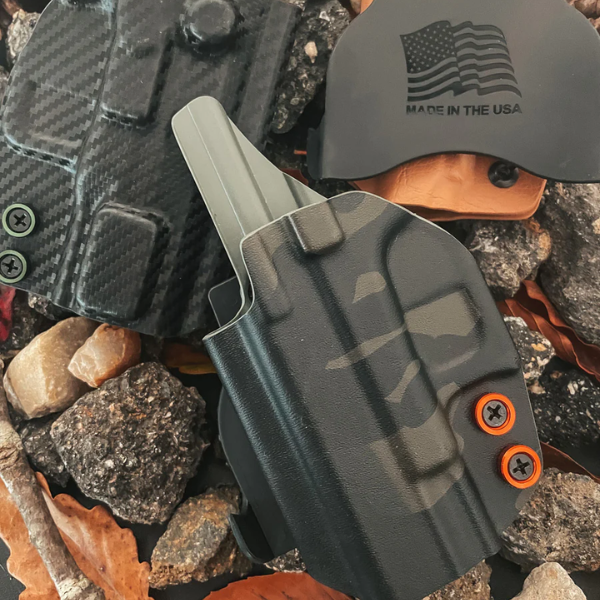Eclipse Holsters, the premier choice for concealed carry enthusiasts, offers a range of meticulously crafted holsters designed for both comfort and discretion. Whether you prefer the stealth of an IWB holster or the readiness of an OWB option, Eclipse Holsters ensures that your firearm is secure and accessible when you need it most.
Concealed vs. Open Carry Key Takeaways:
-
Concealed carry involves hiding a firearm from public view, often requiring a permit, and offers the advantage of discretion and surprise in self-defense scenarios.
-
Open carry refers to carrying a firearm in plain sight, which can deter potential threats but may also invite unwanted attention and legal complexities.
-
Familiarizing oneself with state laws and regulations is essential when considering open or concealed carry, as regulations can vary dramatically from one state to another.
As responsible gun owners, we're faced with important decisions about how to carry our firearms safely and legally. In this guide, we'll explore the nuances of open carry and concealed carry to help you make an informed decision that aligns with your values, lifestyle, and legal requirements.
What Does "Concealed Carry" Mean?
Concealed carry is the art of discreetly carrying a firearm, hidden from view, and typically secured with a holster beneath clothing. It offers surprise defense advantages, and most states require a concealed carry permit. The right clothing and concealed carry holster are necessary for successful concealment, impacting both comfort and the ease of accessing the weapon.
What Does "Open Carry" Mean?
Open carry refers to visibly carrying a firearm outside one's clothing, typically in a holster. It's permitted in many states but may have limitations like magazine capacity or local restrictions. Advocates value its deterrent effect and quick access to their firearms. However, it can be uncomfortable and attract unwanted attention in some settings, potentially increasing the risk of being targeted. Laws vary by state, with some requiring permits and others having more relaxed regulations.
Concealed Versus Open Carry: Choosing the Best Holster
Several factors come into play when selecting the right holster for carrying a firearm. We'll talk about how personal preference, state laws, and comfort play a role in picking the right holster.

1. Personal Preference
Selecting a holster reflects individual needs, including lifestyle, attire, and self-defense strategy. Those valuing stealth may choose concealed holsters for unseen carry, while others favoring prompt access might opt for open carry holsters for visible and quick retrieval. Personal taste also guides our choices between the Inside the Waistband (IWB) and Outside the Waistband (OWB) styles.
2. State Laws and Regulations
State and local laws play a significant role in holster selection. Depending on where we live, we may be limited to only carrying concealed, or openly carrying a firearm might be the only option. Some states have specific requirements for the type of holster used for open carry, such as those that cover the trigger guard or have active retention features. It's imperative to choose a holster that not only meets our personal needs but also adheres to the legal requirements set forth by our state laws.
3. Comfort and Accessibility
Finally, comfort and accessibility are key when choosing either type of holster. An uncomfortable holster might discourage consistent carry, undermining its defensive purpose. Equally, a holster that hinders quick access can be a liability in critical moments. It's essential to consider the holster's fit, material, and design to strike a balance between comfort and function, ensuring confident and responsible firearm carry.
Eclipse Holsters: Premium Selections
Eclipse Holsters is committed to providing gun owners with various top-quality handmade holsters. Whether you prefer concealed or open carry, our selections are designed to meet the highest standards of craftsmanship, functionality, and style. Our range caters to all preferences, ensuring that you have access to the best possible gear to support your decision to responsibly bear arms.
Inside the Waistband (IWB) Holsters

For those who prioritize discretion and comfort, our Inside the Waistband (IWB) holsters are an excellent choice. Designed to be worn under a cover garment, they keep your firearm securely and comfortably concealed against your body. Our IWB holsters are meticulously crafted to fit a wide range of firearm models, providing a snug fit that ensures both safety and quick accessibility. With Eclipse Holsters, you can carry concealed with confidence, knowing that your firearm is out of sight and ready when needed.
Outside the Waistband (OWB) Holsters

If immediate access and readiness are your top priorities, Eclipse Holsters' Outside the Waistband (OWB) holsters make open carry straightforward and secure. Suitable for wearing outside your clothing, these holsters allow you to openly carry your firearm while maintaining a professional appearance. Our OWB selections are made with durability and practicality in mind, ensuring that your firearm remains safely holstered while still being within easy reach.
Frequently Asked Questions
Is concealed carry legal in the US?
Yes, concealed carry is legal in the United States, but the laws and requirements for obtaining a concealed carry permit vary significantly from state to state. Some states require permits and have specific criteria, including background checks and training, while others may have more relaxed regulations or even permitless carry options under certain conditions.
What is the difference between concealed carry and open carry in the US?
The key distinction between concealed and open carry in the US hinges on visibility and legality. Concealed carry requires concealing firearms and typically requires concealed carry permits, with background checks and training. Conversely, open carry is the practice of visibly wearing a firearm. State laws for both vary, ranging from permitless carry to highly regulated.

